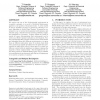Free Online Productivity Tools
i2Speak
i2Symbol
i2OCR
iTex2Img
iWeb2Print
iWeb2Shot
i2Type
iPdf2Split
iPdf2Merge
i2Bopomofo
i2Arabic
i2Style
i2Image
i2PDF
iLatex2Rtf
Sci2ools
GECCO
2007
Springer
2007
Springer
Environment as a spatial constraint on the growth of structural form
We explore the use of the developmental environment as a spatial constraint on a model of Artificial Embryogeny, applied to the growth of structural forms. A Deva model is used to translate genotype to phenotype, allowing a Genetic Algorithm to evolve Plane Trusses. Genomes are expressed in one of several developmental environments, and selected using a fitness function favouring stability, height, and distribution of pressure. Positive results are found in nearly all cases, demonstrating that environment can be used as an effective spatial constraint on development. Further experiments take genomes evolved in some environment and transplant them into different environments, or re-grow them at different phenotypic sizes; It is shown that while some genomes are highly specialized for the particular environment in which they evolved, others may be re-used in a different context without significant re-design, retaining the majority of their original utility. This strengthens the n...
| Added | 07 Jun 2010 |
| Updated | 07 Jun 2010 |
| Type | Conference |
| Year | 2007 |
| Where | GECCO |
| Authors | Taras Kowaliw, Peter Grogono, Nawwaf N. Kharma |
Comments (0)

